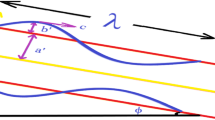Abstract
This paper theoretically analyzes the heat transfer characteristics associated with electroosmotic flow of blood through a micro-vessel having permeable walls. The analysis is based on the Debye–Hückel approximation for charge distributions and the Navier–Stokes equations are assumed to represent the flow field in a rotating system. The velocity slip condition at the vessel walls is taken into account. The essential features of the rotating electroosmotic flow of blood and associated heat transfer characteristics through a micro-vessel are clearly highlighted by the variation in the non-dimensional flow velocity, volumetric flow rate and non-dimensional temperature profiles. Moreover, the effect of Joule heating parameter and Prandtl number on the thermal transport characteristics are discussed thoroughly. The study reveals that the flow of blood is appreciably influenced by the elctroosmotic parameter as well as rotating Reynolds number.















Similar content being viewed by others
Abbreviations
- \((u^{\prime},\,v^{\prime})\) :
-
Velocity components in \(x^{\prime}\) and \(y^{\prime}\) directions recpectively
- \(T^{\prime}\) :
-
Temperature of blood
- \(T_0\) :
-
Lower wall temperature
- \(T_w\) :
-
Upper wall temperature
- \(\Omega\) :
-
Angular velocity in \(y^{\prime}\) direction
- \(v_0\) :
-
Scale of suction/injection velocity
- h :
-
Half-width of micro-vessel
- \(\mu\) :
-
Dynamic viscosity of blood
- \(\nu\) :
-
Kinematic viscosity of blood
- \(\rho\) :
-
Density of blood
- \(\rho _e\) :
-
EDL charge density
- \(\sigma\) :
-
Electrical conductivity
- \(\epsilon\) :
-
Dielectric constant of blood
- \(\lambda _D\) :
-
Debye length
- \(\alpha\) :
-
Ionic energy parameter
- g :
-
Acceleration due to gravity
- \(c_p\) :
-
Specific heat at constant pressure
- k :
-
Electro-osmotic parameter
- S :
-
Suction/injection parameter
- \(\lambda\) :
-
Buoyancy parameter
- Pr :
-
Prandtl number
- \(\gamma 1\) :
-
Joule heating parameter
- \(\beta 1\) :
-
Slip parameter
- Re :
-
Reynolds number
- \(\omega\) :
-
Rotating Reynolds number
References
Islam N, Wu J (2006) Microfluidic transport by AC electroosmosis. J Phys Conf Ser 34:356–361
Wong PK, Wong JT, Deval JH, Ho CM (2004) Electrokinetic in micro devices for biotechnology applications. IEEE/ASME Trans Mechatron 9:366–376
Sharp KA, Honig B (1990) Electrostatic interactions in macromolecules: theory and applications. Annu Rev Biophys Biophys Chem 19:301–332
Stone HA, Stroock AD, Ajdari A (2004) Engineering flows in small devices: microfluidics toward a lab-on-a-chip. Annu Rev Fluid Mech 36:381–411
Ohno K, Tachikawa K, Manz A (2008) Microfluidics: applications for analytical purposes in chemistry and biochemistry. Electrophoresis 29:4443–4453
Gravesen P, Branebjerg J, Jensen OS (1993) Microfluidics—a review. J Micromech Microeng 3:168
Becker H, Gartner C (2000) Polymer microfabrication methods for microfluidic analytical applications. Electrophoresis 21:12–26
Laser DJ, Santiago JG (2004) A review of micropumps. J Micromech Microeng 14:35–64
Duffy DC, Gillis HL, Lin J, Sheppard NF, Kellongg GJ (1999) Microfabricated centrifugal microfluidic systems: characterization and multiple enzymatic assays. Anal Chem 71:4669–4678
Burgreen D, Nakache FR (1964) Electrokinetic flow in ultrafine capillary slit. J Phys Chem 68:1084–1091
Rice CL, Whitehead R (1965) Electrokinetic flow in a narrow cylindrical capillary. J Phys Chem 69:4017–4024
Siddiqui AA, Lakhtakia A (2009) Steady electroosmotic flow of a micropolar fluid in a microchannel. Proc R Soc A Math Phys Eng Sci 465:501–522
Ng CO, Qi C (2015) Electro-osmotic flow in a rotating rectangular microchannel. Proc R Soc A Math Phys Eng Sci. doi:10.1098/rspa.2015.0200
Hopfinger EJ, Linden PF (1990) The eect of background rotation on fluid motions. J Fluid Mech 211:417–435
Luo WJ, Pan YJ, Yang J (2005) Transient analysis of electro-osmotic secondary flow induced by DC or AC electric field in a curved rectangular microchannel. J Micromech Microeng 15:463–473
Chang CC, Wang CY (2011) Rotating electro-osmotic flow over a plate or between two plates. Phys Rev E 84:056320:1–056320:7
Chen CH (2011) Electroosmotic heat transfer of non-Newtonian fluid flow in microchannels. J Heat Transfer ASME 133:071705
Liao Q, Zhu X, Wen TY (2009) Thermal effects on mixed electro-osmotic and pressure-driven flows in triangle microchannels. Appl Therm Eng 29:807–814
Maynes D, Webb BW (2003) Fully developed electro-osmotic heat transfer in microchannels. Int J Heat Mass Transfer 46:1359–1369
Chakraborty S (2006) Analytical solutions of nusselt number for thermally fully developed flow in microtubes under a combined action of electroosmotic forces and imposed pressure gradients. Int J Heat Mass Transfer 49:810–813
Jain A, Jensen MK (2007) Analytical modeling of electrokinetic effects on flow and heat transfer in microchannels. Int J Heat Mass Transfer 50:5161–5167
Husain A, Kim KY (2011) Thermal transport and performance analysis of pressure- and electroosmotically-driven liquid flow microchannel heat sink with wavy wall. Heat Mass Transf 47:93–105
Acknowledgments
The authors wish to convey their sincere thanks to all the esteemed reviewers for their comments and suggestions based upon which the present version of the manuscript has been revised. One of the authors (A. Mondal) is sincerely thankful to UGC, New Delhi, while the other authors are greatly acknowledge to SERB, Department of Science and Technology (DST), New Delhi, for the financial support of this investigation.
Author information
Authors and Affiliations
Corresponding author
Rights and permissions
About this article
Cite this article
Sinha, A., Mondal, A., Shit, G.C. et al. Effect of heat transfer on rotating electroosmotic flow through a micro-vessel: haemodynamical applications. Heat Mass Transfer 52, 1549–1557 (2016). https://doi.org/10.1007/s00231-015-1673-5
Received:
Accepted:
Published:
Issue Date:
DOI: https://doi.org/10.1007/s00231-015-1673-5




